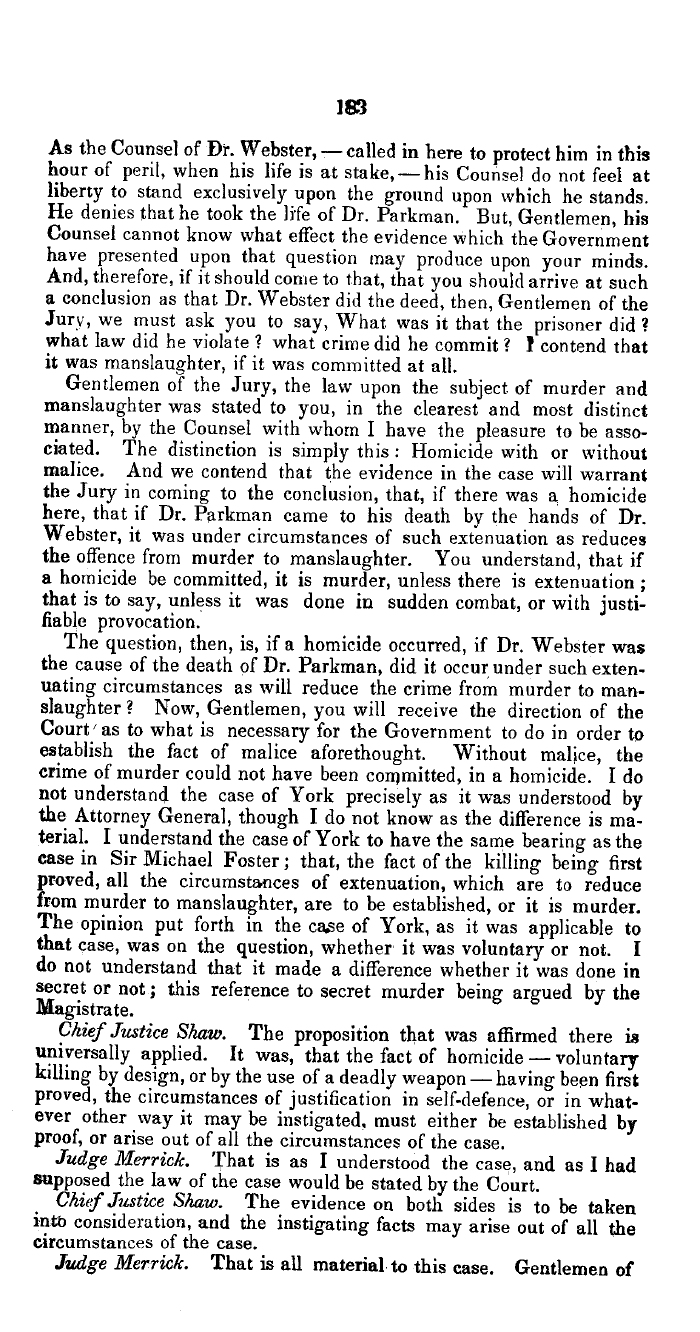|
183
As the Counsel of Dr. Webster, -called in here to protect him in this
hour of peril, when his life is at stake,-his Counsel do not feel at
liberty to stand exclusively upon the ground upon which he stands.
He denies that he took the life of Dr. Parkman. But, Gentlemen, his
Counsel cannot know what effect the evidence which the Government
have presented upon that question may produce upon your minds.
And, therefore, if it should come to that, that you should arrive at such
a conclusion as that Dr. Webster did the deed, then, Gentlemen of the
Jury, we must ask you to say, What was it that the prisoner did ?
what law did he violate ? what crime did he commit ? Z contend that
it was manslaughter, if it was committed at all.
Gentlemen of the Jury, the law upon the subject of murder and
manslaughter was stated to you, in the clearest and most distinct
manner, by the Counsel with whom I have the pleasure to be asso-
ciated. The distinction is simply this : Homicide with or without
malice. And we contend that the evidence in the case will warrant
the Jury in coming to the conclusion, that, if there was a homicide
here, that if Dr. Parkman came to his death by the hands of Dr.
Webster, it was under circumstances of such extenuation as reduces
the offence from murder to manslaughter. You understand, that if
a homicide be committed, it is murder, unless there is extenuation ;
that is to say, unless it was done in sudden combat, or with justi-
fiable provocation.
The question, then, is, if a homicide occurred, if Dr. Webster was
the cause of the death of Dr. Parkman, did it occur under such exten-
uating circumstances as will reduce the crime from murder to man-
slaughter ? Now, Gentlemen, you will receive the direction of the
Court, as to what is necessary for the Government to do in order to
establish the fact of malice aforethought. Without malice, the
crime of murder could not have been committed, in a hornicide. I do
not understand the case of York precisely as it was understood by
the Attorney General, though I do not know as the difference is ma-
terial. I understand the case of York to have the same bearing as the
case in Sir Michael Foster; that, the fact of the killing being first
proved, all the circumstances of extenuation, which are to reduce
from murder to manslaughter, are to be established, or it is murder.
The opinion put forth in the case of York, as it was applicable to
that case, was on the question, whether it was voluntary or not. I
do not understand that it made a difference whether it was done in
secret or not; this reference to secret murder being argued by the
Magistrate.
Chief Justice Shaw. The proposition that was affirmed there is
universally applied. It was, that the fact of homicide - voluntary
killing by design, or by the use of a deadly weapon - having been first
proved, the circumstances of justification in self-defence, or in what-
ever other way it may be instigated, must either be established by
proof, or arise out of all the circumstances of the case.
Judge Merrick. That is as I understood the case, and as I had
supposed the law of the case would be stated by the Court.
Chief Justice Shaw. The evidence on both sides is to be taken
into consideration, and the instigating facts may arise out of all the
circumstances of the case.
Judge Merrick. That is all material to this case. Gentlemen of
|

